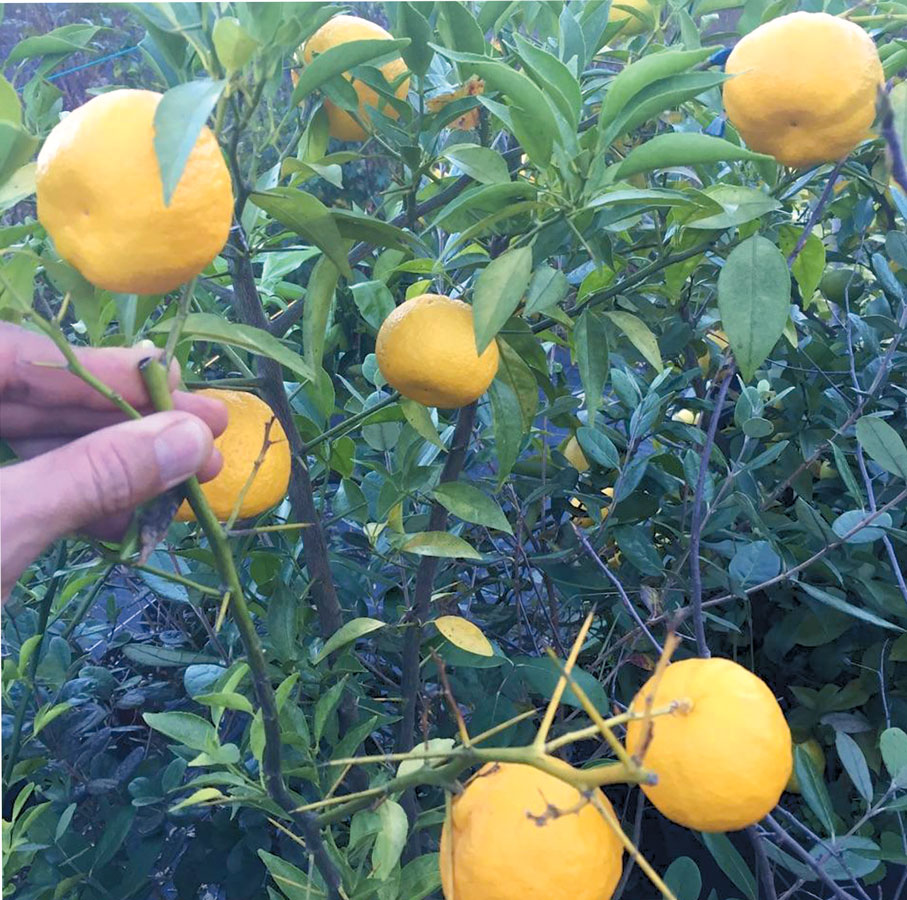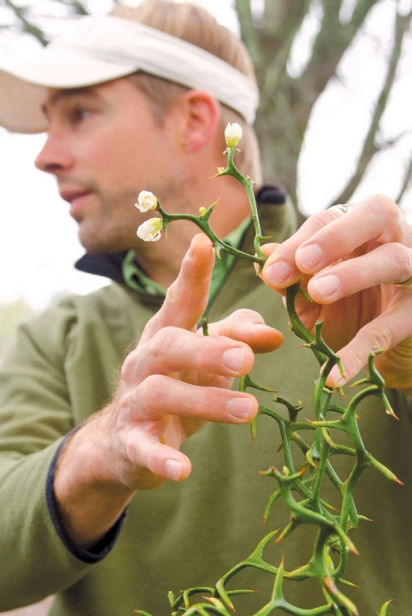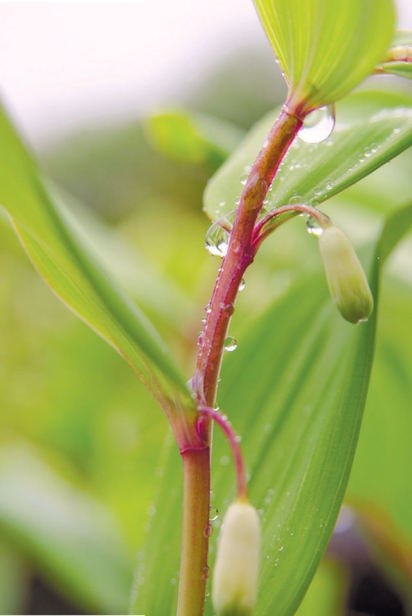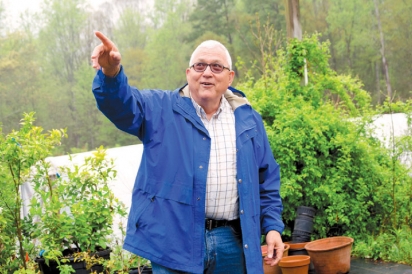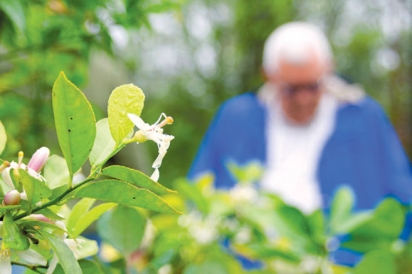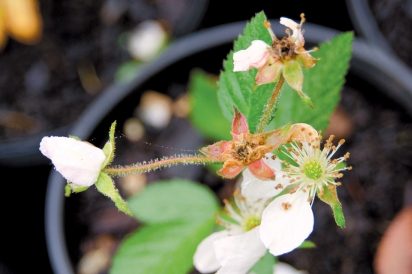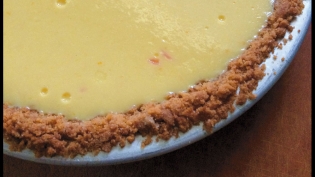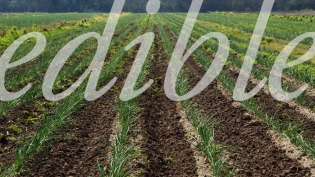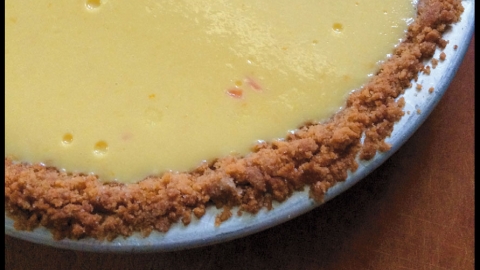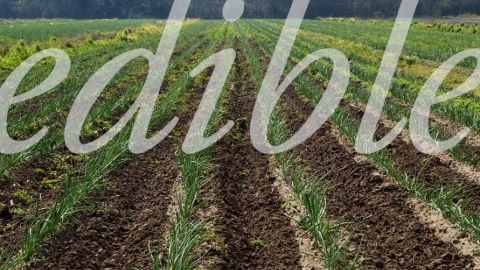An Orange in Winter
Nat Bradford Expands What’s Possible in Local Fruit
When you meet landscape architect and farmer Nat Bradford, you know you’re in the presence of a game changer.
The properties of his Lake Keowee clients are edible landscapes. Blueberries, buckwheat, squash and fruit trees—including pawpaws—are interplanted in what Nat calls “food meadows.” Runoff from the front yard of one of the homes is channeled around the side and filtered through striking patches of Joe Pye weed and Louisiana iris, which clean the water by capturing debris and sediment. This is not your typical lakefront landscape.
Nat and business partner Randy Peele (who started Carolina Gardener magazine back in the 1980s) own a nursery in Seneca that focuses on edible and otherwise useful plants. Ramps are a new product for them this year, grown to simultaneously satisfy the needs of chefs and combat the overharvesting of the alliums in the wild. The nursery soon will move to Nat’s family farm in Sumter, where he’s already growing Bradford watermelons and Bradford collards, a green that, according to heirloom expert David Shields, has a complex and satisfying flavor profile.
A key point of Nat’s agricultural philosophy is the belief that preserving heirloom varieties doesn’t mean that they should be frozen in time. Each year, he selects certain melons to save seed, choosing those best adapted to their environment. He’s always looking forward and improving his family’s varieties. It’s wrong, he says, to think that heirlooms don’t and shouldn’t change.
Nat’s passion, though, is growing cold hardy citrus trees. That project is spurred both by his desire to “grow everything for my breakfast on my own farm,” and by concern over citrus greening, a disease that has devastated citrus growers worldwide. The virus is transmitted when an insect carrier bites the bark or leaves of citrus plants. There is no cure. Cold hardy citrus, he believes, might be the answer; the host insects may not be able to survive the low temperatures that his trees could.
His interest in citrus breeding began with a hunt for a cold hardy variety for a landscaping project. He intended to use Citrus ichangensis, a lemon cross that he had found to be hardy to 4°. He couldn’t locate one, and with the end of the project looming before him, made a quick visit to Ted Stevens at Nurseries Caroliniana in North Augusta. Ted suggested a fruiting Citrus taiwanica, a sour orange with marked similarities to easy-peeling tangerines and Satsumas.
Nat acknowledges that citrus species are so closely related to each other that even horticulturists have difficulty separating and identifying true species. There are only four wild, true-breeding species (citron, pomelo, mandarin and key lime). All others, including sweet oranges, limes, lemons and grapefruit, are hybrids. Citrus taiwanica is an ancient hybrid that originated in Taiwan. Today, it’s almost extinct in its native range and has become a specimen prized by citrus enthusiasts worldwide.
Although the taiwanica’s fruit initially was described to him as too sour to eat out-of-hand, Nat’s wife Bette immediately liked the flavor. Their five children will happily eat the thick, deep yellow rind by itself, he says.
Working with sour orange gave Nat the idea of creating improved varieties of cold hardy citrus. Many breeders use trifoliate orange (Poncirus trifoliata) as rootstock for citrus grafting because of its resistance to soil pathogens and its cold hardiness, to -5°. (Trifoliate orange is not actually a citrus, but is a close relative.) Nat could have used the trifoliate orange in his hybridization trials, but wanted to start with a better-flavored variety.
Citrus taiwanica was the logical choice, both for flavor and for breeding in cold tolerance. Nat’s trees have withstood 7° temperatures two years in a row, and his family has harvested fruits in 25° weather. Last year, he crossed a taiwanica with a cold hardy grapefruit. Out of all the crosses, only one fruit set. He’s planted the seed from that fruit, but will have to wait three years for the plants to bloom.
He now has over 20 citrus taiwanica trees in the ground in Sumter. Several hundred more are in seed packs, ready to be planted out in the spring.
Nat believes that breeding cold hardy citrus could help create new agricultural markets in South Carolina. His next project will be the development of a blood orange cross that is cold resistant, a fruit tree different from everything else on the market today. He’s especially interested in the blood orange because it’s the only citrus that contains anthocyanins, pigments high in antioxidants. So not only does he grow his breakfast, but an extra healthy one at that.
Nat Bradford
Eco-Art Landscape Architects
864-710-1124
www.ecoartllc.com


